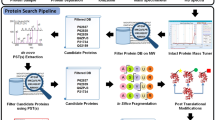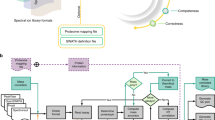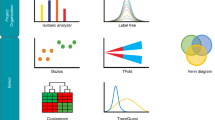Abstract
Shotgun proteomics yields tandem mass spectra of peptides that can be identified by database search algorithms. When only a few observed peptides suggest the presence of a protein, establishing the accuracy of the peptide identifications is necessary for accepting or rejecting the protein identification. In this protocol, we describe the properties of peptide identifications that can differentiate legitimately identified peptides from spurious ones. The chemistry of fragmentation, as embodied in the 'mobile proton' and 'pathways in competition' models, informs the process of confirming or rejecting each spectral match. Examples of ion-trap and tandem time-of-flight (TOF/TOF) mass spectra illustrate these principles of fragmentation.
This is a preview of subscription content, access via your institution
Access options
Subscribe to this journal
Receive 12 print issues and online access
$259.00 per year
only $21.58 per issue
Buy this article
- Purchase on Springer Link
- Instant access to full article PDF
Prices may be subject to local taxes which are calculated during checkout









Similar content being viewed by others
References
Eng, J.K., McCormack, A.L. & Yates, J.R. III. An approach to correlate tandem mass spectral data of peptides with amino acid sequences in a protein database. J. Am. Soc. Mass Spectrom. 5, 976–989 (1994).
Perkins, D.N., Pappin, D.J., Creasy, D.M. & Cottrell, J.S. Probability-based protein identification by searching sequence databases using mass spectrometry data. Electrophoresis 20, 3551–3567 (1999).
Washburn, M.P., Wolters, D. & Yates, J.R. III . Large-scale analysis of the yeast proteome by multidimensional protein identification technology. Nat. Biotechnol. 19, 242–247 (2001).
Daikoku, T. et al. Proteomic analysis identifies immunophilin FK506 binding protein 4 (FKBP52) as a downstream target of Hoxa10 in the periimplantation mouse uterus. Mol. Endocrinol. 19, 683–697 (2005).
Wysocki, V.H., Tsaprailis, G., Smith, L.L. & Breci, L.A. Mobile and localized protons: a framework for understanding peptide dissociation. J. Mass Spectrom. 35, 1399–1406 (2000).
Paizs, B. & Suhai, S. Fragmentation pathways of protonated peptides. Mass Spectrom. Rev. 24, 508–548 (2005).
Huang, Y., Wysocki, V.H., Tabb, D.L. & Yates, J.R. III . The influence of histidine on cleavage C-terminal to acidic residues in doubly protonated tryptic peptides. Int. J. Mass Spectrom. 219, 233–244 (2002).
Schlosser, A., Pipkorn, R., Bossemeyer, D. & Lehmann, W.D. Analysis of protein phosphorylation by a combination of elastase digestion and neutral loss tandem mass spectrometry. Anal. Chem. 73, 170–176 (2001).
Reid, G.E., Roberts, K.D., Kapp, E.A. & Simpson, R.I. Statistical and mechanistic approaches to understanding the gas-phase fragmentation behavior of methionine sulfoxide containing peptides. J. Proteome Res. 3, 751–759 (2004).
Syka, J.E., Coon, J.J., Schroeder, M.J., Shabanowitz, J. & Hunt, D.F. Peptide and protein sequence analysis by electron transfer dissociation mass spectrometry. Proc. Natl. Acad. Sci. USA 101, 9528–9533 (2004).
Breci, L.A., Tabb, D.L., Yates, J.R. III. & Wysocki, V.H. Cleavage N-terminal to proline: analysis of a database of peptide tandem mass spectra. Anal. Chem. 75, 1963–1971 (2003).
Tabb, D.L. et al. Statistical characterization of ion trap tandem mass spectra from doubly charged tryptic peptides. Anal. Chem. 75, 1155–1163 (2003).
Paizs, B. & Suhai, S. Towards understanding some ion intensity relationships for the tandem mass spectra of protonated peptides. Rapid Commun. Mass Spectrom. 16, 1699–1702 (2002).
Tabb, D.L., Huang, Y., Wysocki, V.H. & Yates, J.R. III . Influence of basic residue content on fragment ion peak intensities in low-energy collision-induced dissociation spectra of peptides. Anal. Chem. 76, 1243–1248 (2004).
Ballard, K.D. & Gaskel, S.J. Dehydration of peptide [M+H]+ ions in the gas phase. J. Am. Soc. Mass Spectrom. 4, 477–481 (1993).
Hunt, D.F., Yates, J.R. III, Shabanowitz, J., Winston, S. & Hauer, C.R. Protein sequencing by tandem mass spectrometry. Proc. Natl. Acad. Sci. USA 83, 6233–6237 (1986).
Jonscher, K.R. & Yates, J.R. III . The quadrupole ion trap mass spectrometer–a small solution to a big challenge. Anal. Biochem. 244, 1–15 (1997).
Chernushevich, I.V., Loboda, A.V. & Thomson, B.A. An introduction to quadrupole-time-of-flight mass spectrometry. J. Mass Spectrom. 36, 849–865 (2001).
Medzihradszky, K.F. et al. The characteristics of peptide collision-induced dissociation using a high-performance MALDI-TOF/TOF tandem mass spectrometer. Anal. Chem. 72, 552–558 (2000).
Fenyo, D. & Beavis, R.C. A method for assessing the statistical significance of mass spectrometry-based protein identifications using general scoring schemes. Anal. Chem. 75, 768–774 (2003).
Craig, R. & Beavis, R.C. TANDEM: matching proteins with tandem mass spectra. Bioinformatics 20, 1466–1467 (2004).
Geer, L.Y. et al. Open mass spectrometry search algorithm. J. Proteome Res. 3, 958–964 (2004).
Link, A.J. et al. Direct analysis of protein complexes using mass spectrometry. Nat. Biotechnol. 17, 676–682 (1999).
Cargile, B.J., Bundy, J.L. & Stephenson, J.L. Jr. Potential for false positive identifications from large databases through tandem mass spectrometry. J. Proteome Res. 3, 1082–1085 (2004).
Higdon, R., Hogan, J.M., Van Belle, G. & Kolker, E. Randomized sequence databases for tandem mass spectrometry peptide and protein identification. OMICS 9, 364–379 (2005).
Keller, A., Nesvizhskii, A.I., Kolker, E. & Aebersold, R. Empirical statistical model to estimate the accuracy of peptide identifications made by MS/MS and database search. Anal. Chem. 74, 5383–5392 (2002).
Chen, Y., Kwon, S.W., Kim, S.C. & Zhao, Y. Integrated approach for manual evaluation of peptides identified by searching protein sequence databases with tandem mass spectra. J. Proteome Res. 4, 998–1005 (2005).
Gibbons, F.D., Elias, J.E., Gygi, S.P. & Roth, F.P. SILVER helps assign peptides to tandem mass spectra using intensity-based scoring. J. Am. Soc. Mass Spectrom. 15, 910–912 (2004).
Lilley, K.S. & Friedman, D.B. All about DIGE: quantification technology for differential-display 2D-gel proteomics. Expert Rev. Proteomics 1, 401–409 (2004).
Tabb, D.L., Narasimhan, C., Strader, M.B. & Hettich, R.L. DBDigger: reorganized proteomic database identification that improves flexibility and speed. Anal. Chem. 77, 2464–2474 (2005).
Kapp, E.A. et al. Mining a tandem mass spectrometry database to determine the trends and global factors influencing peptide fragmentation. Anal. Chem. 75, 6251–6264 (2003).
Geiger, T. & Clarke, S. Deamidation, isomerization, and racemization at asparaginyl and aspartyl residues in peptides. Succinimide-linked reactions that contribute to protein degradation. J. Biol. Chem. 262, 785–794 (1987).
Tsaprailis, G. et al. A mechanistic investigation of the enhanced cleavage at histidine in the gas-phase dissociation of protonated peptides. Anal. Chem. 76, 2083–2094 (2004).
Bradshaw, R.A. Revised draft guidelines for proteomic data publication. Mol. Cell. Proteomics 4, 1223–1225 (2005).
Carr, S. et al. The need for guidelines in publication of peptide and protein identification data: Working Group on Publication Guidelines for Peptide and Protein Identification Data. Mol. Cell. Proteomics 3, 531–533 (2004).
Yang, X. et al. DBParser: web-based software for shotgun proteomic data analyses. J. Proteome Res. 3, 1002–1008 (2004).
Tabb, D.L., McDonald, W.H. & Yates, J.R. III . DTASelect and Contrast: tools for assembling and comparing protein identifications from shotgun proteomics. J. Proteome Res. 1, 21–26 (2002).
Acknowledgements
This work was supported by US National Institutes of Health grant P30 ES000267, by an American Cancer Society Institutional Research Grant (no. IRG-58-009-48) through the Sartain-Lanier Family Foundation and Vanderbilt-Ingram Cancer Center Discovery Grant Programs, and by the Vanderbilt Academic Venture Capital Fund. M. Tyska (Vanderbilt University; supported by a Career Development Award from the Crohn's and Colitis Foundation of America) contributed the spectra of mouse brush border proteins, and R. Peek and A. Franco (Vanderbilt University) contributed H. pylori membrane samples.
Author information
Authors and Affiliations
Corresponding author
Ethics declarations
Competing interests
The authors declare no competing financial interests.
Rights and permissions
About this article
Cite this article
Tabb, D., Friedman, D. & Ham, AJ. Verification of automated peptide identifications from proteomic tandem mass spectra. Nat Protoc 1, 2213–2222 (2006). https://doi.org/10.1038/nprot.2006.330
Published:
Issue Date:
DOI: https://doi.org/10.1038/nprot.2006.330
This article is cited by
-
Role of PLK1/NUMB/NOTCH in epithelial-mesenchymal transition in human melanoma
npj Precision Oncology (2024)
-
Absolute protein quantitation of the mouse macrophage Toll-like receptor and chemotaxis pathways
Scientific Data (2022)
-
Cytochrome c adducts with PCB quinoid metabolites
Environmental Science and Pollution Research (2016)
-
Global, in situ, site-specific analysis of protein S-sulfenylation
Nature Protocols (2015)
-
Unravelling associations between unassigned mass spectrometry peaks with frequent itemset mining techniques
Proteome Science (2014)
Comments
By submitting a comment you agree to abide by our Terms and Community Guidelines. If you find something abusive or that does not comply with our terms or guidelines please flag it as inappropriate.



